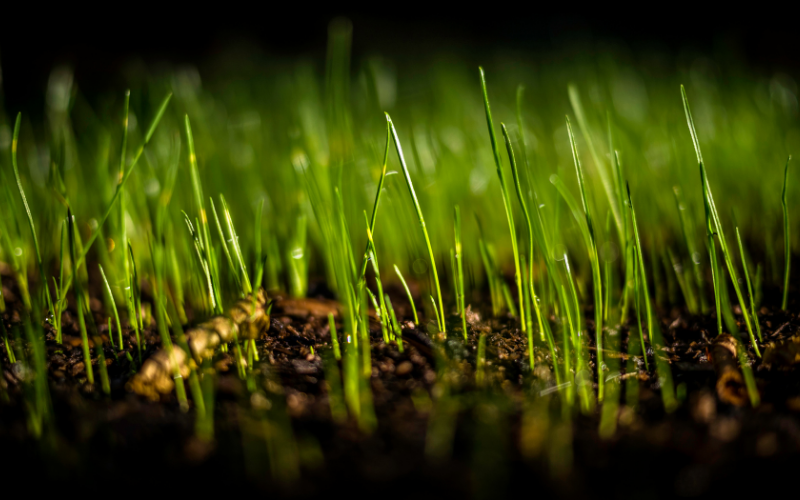“Watching the grass grow” is an expression for something that happens very slowly. However, after a busy few weeks and no time to mow your lawn, you may notice that your grass seems to grow faster than you’d expect. Or you may notice that it seemingly hasn’t grown an inch in the height of summer. How much does grass grow in a day? And can you change that rate?
How Much Does Grass Grow in a Day?
The common types of lawn grass, including zoysia, fescue, and ryegrass, will only grow about 1/10 of an inch a day in their growing seasons. If conditions are just right, this rate can double to about 1/5 of an inch per day. If it is too cold or too hot, most species of grass will go dormant. In this state, they are still alive but will not grow.
How Fast Does Grass Grow in Summer?
How fast grass will grow in the summer will depend on the temperature. Most grass species have a “sweet spot” for growth. In nearly all cases, this spot hovers around 75F. If well fed and hydrated, grass will grow at the usual rate of 1/5 an inch per day in these conditions. If dehydrated during this time, the grass may become dormant, slow its growth rate, or stop growing altogether.
At higher temperatures such as 90F or above, most “cool season” grasses or grasses that grow best in cooler weather will go dormant to avoid taking damage, just like they would do in the winter. Warm season grasses will continue to grow, though even they will do so slower than they would in slightly cooler weather unless they are watered several times a day.
How Fast Does Grass Grow in Winter?
Just like in summer, the growth rate of grass in winter is determined by temperature and resources. If temperatures are below freezing, grass will either be dormant, dead, or taking damage. Warm season grasses, for example, are usually not tolerant of frost or freezing conditions. By that same token, cool season grasses will survive the winter with no damage but take damage during the peak of summer in hot climates.
At just 55F, most grasses will slow their growth rate and go dormant. This is too cool a temperature for most lawns to continue to grow, even with plentiful light and other resources. At 32F, grasses such as zoysia will begin to die back and, with continued cold, may not survive this temperature. Cool season grasses such as fescue and ryegrass, however, will “go to sleep” and rest over the winter. When conditions improve and it warms up again, the grass will “wake up” and continue to grow normally.
What Determines How Fast Grass Grows?
The growth rate of grass is largely determined by type and temperature, with several other influential factors detailed below.
- Variety – Grass has been cultivated for thousands of years. Different grasses have adapted and been adapted to varying circumstances and even specific strains, both patented and not, within those varieties can have very different growth rates and required circumstances for growth.
- Temperature – As mentioned in the sections above, few common types of grass grow well above 85F and almost no grass will grow as temperatures approach freezing.
- Nutrients – If grass has no access to the nutrients it needs to survive, it won’t grow.
- Hydration – Lack of water can easily stunt or stall the growth of grass, especially in hot weather and dry climates.
- Health or Damage – Damaged grass will grow more slowly or won’t grow at all. While damage to the blade of the grass is largely ignored, damage to the roots and root system can be problematic if you want to encourage growth.
Grass Growth Rate Is Heavily Influenced By Type and Temperature
Common varieties of grass used to create manageable lawns all have similar growth rates. Unlike some wild prairie grasses that can grow inches each day, these varieties have been selected and cultivated for manageable growth rates as well as durability. The biggest factor that determines how much grass grows is the temperature. The closer that temperature is to the sweet spot of growth for that type of grass, or about 70F, the more it will grow per day.
| Grass Variety | Growth Rate at 30F | Growth Rate at 60F | Growth at 75F | Growth Rate at 90F |
|---|---|---|---|---|
| Zoysia (Warm Season) | Declining (Dead) | 2 to 3 Inches Per Month | 3 to 5 Inches Per Month | 2 to 3 inches per month |
| St. Augustine (Warm Season) | Dormant (Not Growing But Alive) | 1 Inch Per Month | 2 to 3 Inches Per Month | Dormant |
| Tall Fescue (Cool Season) | Dormant (Not Growing But Alive) | 2 to 4 Inches Per Month | 1 to 2 Inches Per Month | Dormant (Damage Possible) |
| Perennial Ryegrass (Cool Season) | Dormant (Not Growing But Alive) | 2 to 4 Inches Per Month | 3 to 5 Inches Per Month | Dormant (Damage Possible) |




Leave a Reply